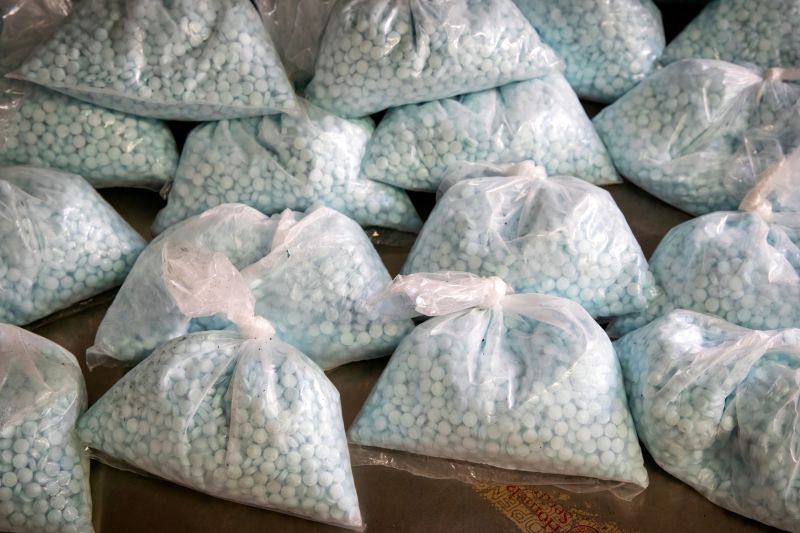The US Drug Enforcement Administration says that less fentanyl is present in the nation’s illicit pill supply and that is helping drive down overdose deaths in the United States. But experts say that there are limitations to this claim and that many other factors are probably playing a role.
About 5 out of every 10 fentanyl pills that the agency tested this year had lethal doses of the synthetic opioid painkiller fentanyl, down from about 7 in 10 last year, DEA Administrator Anne Milgram said last week at a summit for families who have lost a loved one to a fentanyl overdose.
Federal data also shows that overdose deaths dropped nearly 15% between this June and last. There were about 16,000 fewer lives lost in the most recent 12-month period, according to estimates from the US Centers for Disease Control and Prevention – and the vast majority of the decrease was in deaths involving fentanyl and other synthetic opioids.
“Decreases in drug related deaths and the lethality of pills equals lives saved,” Milgram said in a statement. “The cartels have reduced the amount of fentanyl they put into pills because of the pressure we are putting on them.”
In May, the DEA released a report outlining the illicit drug threats facing the US. The agency’s “top operational priority is to relentlessly pursue and defeat the two Mexican drug cartels – the Sinaloa Cartel and the Jalisco Cartel – that are primarily responsible for driving the current fentanyl poisoning epidemic in the United States,” the report said.
Experts say there are some other critical gaps in the DEA analysis that weaken the potential link between the amount of fentanyl present in the drug supply and the drop in overdose deaths.
For example, the DEA tested pills, but experts say illicit fentanyl is more commonly found and used in powder form.
The latest testing data from the Center for Forensic Science Research and Education shows a slight downward trend in the average purity of fentanyl powder in a drug supply that’s highly variable, said Dr. Alex Krotulski, director of toxicology and chemistry at the organization, which partners with groups across the US to test and analyze drug samples.
“Changes in the drug supply can have immediate impacts on fatalities, but it would be my hypothesis that those changes would have to be very abrupt and very significant changes,” he said. The small dip in the amount of fentanyl in the drug supply in the data from his lab would be far from enough to explain thousands of fewer deaths.
The measurement that the DEA uses to define a deadly dose of fentanyl – 2 milligrams – is also subjective. Individual responses to fentanyl can vary based on the person’s tolerance to the drug, as well as physical and genetic characteristics.
“There just is so much variability and no set way to put a number on that,” Krotulski said. And broader variability – in routes of administration and the mix of other contaminants in the drug supply – makes it hard to tie drops in overdose deaths directly to the changes in fentanyl that the DEA found.
“It’s certainly not just the decrease slightly in the amount of fentanyl in pills, in my opinion,” he said. “It really is likely a collective effort of what’s going on in the public health and public safety realm.”
In a statement last week, Dr. Rahul Gupta, director of the White House Office of National Drug Control Policy, highlighted efforts that the Biden administration has made to help reduce drug overdoses.
“Over the past four years, we have removed decades-long barriers to treatment for millions of Americans, we have made life-saving opioid overdose reversal medications like naloxone more accessible and affordable across the country, and we have invested historic levels of funding to crack down on the supply of illicit fentanyl at the border,” he said.
Milgram also said that many factors have contributed to the decrease in overdose deaths.
“Much work remains, and one death is too many, but today we can find some comfort in the fact that the work we are all doing together – to enforce our laws, to educate Americans on the dangers of fentanyl, to increase access to naloxone and [medications for opioid use disorder] – is saving lives,” she said last week.
Dr. Daniel Ciccarone, a professor at the University of California, San Francisco whose research has focused on illicit drug trends in the US, agrees that there are limitations to the DEA’s analysis of the amount of fentanyl found in pills, but he says it’s one metric that can serve as a helpful starting point.
“Anything that reduces fentanyl exposure is going to lead to a decline in deaths, because that’s the most powerful deadly agent out there right now,” he said.
Recent anecdotes from his work align in ways that suggest there has been a “supply shock” that would indicate less fentanyl in the market: People in both San Francisco and Ohio have told him that the drug is getting weaker, more expensive and harder to find, he said.
The sharp decline in overdose deaths also makes this a likely theory – contrary to other explanations that would lead to more gradual change, he said.
“The sudden decline of double digits reminds me of historic supply shocks,” Ciccarone said, substantial changes that are similar to the way the Covid-19 pandemic affected the supply chain.
- Sign up here to get The Results Are In with Dr. Sanjay Gupta every Friday from the CNN Health team.
“People are sensitive to price, whether you’re a legitimate consumer or consuming an illegitimate drug, and those translate relatively quickly,” he said. “So if the supply shock is meaningful and it changes the street price or purity in a meaningful way, consumption goes down. And when consumption goes down on a population level, you’re going to see benefit. You’re going to see overdoses go down.”
Still, Ciccarone has a few other theories to explain the drop in overdose death, including two that he favors more strongly than the idea of a supply shock.
First, he theorizes that the size of the at-risk population is decreasing; younger people who use illicit drugs are not seeking out fentanyl to the same degree as the older cohort who were exposed to fentanyl when it adulterated the heroin supply.
And second, he suggests that the decreases may simply be a return to average after a significant spike during the height of the Covid-19 pandemic.
In any case, he says, there’s no way to pinpoint a single factor driving overdose deaths down, and the trend may not stick. The illicit drug market is incredibly flexible and resilient.
“I’m not 100% convinced that this phenomenon, whatever it is and whatever’s causing it, lasts another year,” Ciccarone said. “We have to expect the unexpected moving forward. If it happens – unexpectedly, to me – that this persists, then hallelujah.”





